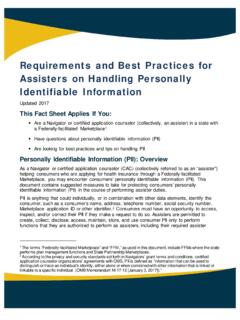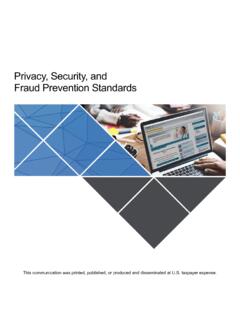Transcription of Incarcerated and Recently Released Consumers
1 March 2022. This information is intended only for the use of entities and individuals certified to serve as Navigators or certified application counselors in a Federally-facilitated Marketplace. The terms Federally-facilitated Marketplace and FFM, as used in this document, include FFMs where the state performs plan management functions. Some information in this manual may also be of interest to individuals helping Consumers in State-based Marketplaces and State-based Marketplaces using the Federal Platform. This document is intended only as a summary of legal requirements and to provide operational information and does not itself create any legal rights or obligations. All legal requirements are fully stated in the applicable statutes and regulations. The contents of this document do not have the force and effect of law and are not meant to bind the public in any way, unless specifically incorporated into a contract. This document is intended only to provide clarity to the public regarding existing requirements under the law.
2 This material was printed, published, or produced and disseminated at taxpayer expense. Incarcerated and Recently Released Consumers This fact sheet provides information and guidance that Navigators and certified application counselors (collectively, assisters) need to know in order to help Consumers who are Incarcerated or Recently Released understand their health coverage options. Marketplace coverage ..1 Medicaid coverage ..4 Medicare coverage ..6 Scenario ..8 Additional Resources ..8 The rules related to coverage of Incarcerated Consumers through a Marketplace are different from the rules that apply to Medicaid, CHIP or Medicare. Marketplace coverage Incarcerated Consumers The Affordable Care Act (ACA) states that Consumers are not eligible to enroll or continue enrollment in a qualified health plan (QHP) through the Health Insurance Marketplaces if they are Incarcerated , unless they are Incarcerated pending disposition of charges. The following table lists Consumers who the Marketplace does and doesn t consider Incarcerated for the purposes of Marketplace eligibility.
3 Status Definitions Incarcerated Consumers Have been convicted of a crime and are sentenced to confinement in an institution such as a correctional facility or inpatient mental health facility These Consumers have 30 days to report their incarceration status to the Marketplace and terminate their existing Marketplace coverage . Consumers NOT Incarcerated Have not been convicted of a crime. Pending disposition of charges. This means the individual has been charged with a crime but is waiting for the outcome of the charges to be determined. This includes situations in which an individual is arrested but not convicted of a crime and convicted of a crime but awaiting sentencing, whether confined to a correctional institution or Released on bail, bond, or other conditional release. Consumers pending disposition of charges can enroll or continue existing enrollment in a QHP through a Marketplace, if otherwise eligible. However, if convicted, Consumers are no longer eligible for Marketplace coverage if they are Incarcerated and should end their existing coverage through a Marketplace.
4 Have been convicted of a crime and are sentenced to a partial, limited, or alternative form of confinement. This includes Consumers who are on probation or parole; living in the community after a sentence has been served; allowed work release; under home confinement; or residing in a halfway house or other type of residential community supervision as a result of a conviction. These Consumers may be eligible to enroll or continue existing enrollment in a QHP through a Marketplace, if otherwise eligible. If Consumers probation or parole is revoked, they are no longer eligible to enroll in a QHP through a Marketplace, and, if already enrolled, they should end their existing coverage through a Marketplace. Marketplace coverage can be terminated by: The enrollee by contacting the Marketplace Call Center at 1-800-318-2596 (TTY: 1-855-889-4325) or by visiting The application filer by contacting the Marketplace Call Center or by visiting Any adult age 18 or over who is on the application and applied for Marketplace coverage by contacting the Marketplace Call Center.
5 An adult age 18 or over listed as a tax filer on the Incarcerated consumer s application for Marketplace coverage , even if the tax filer didn t apply for coverage , by contacting the Marketplace Call Center. An individual authorized on the Incarcerated consumer s behalf, i f neither the Incarcerated consumer nor any adult on the application is able to contact a Marketplace to report a change and end enrollment through the Marketplace, by contacting the Marketplace Call Center. Additionally, individuals can seek help with the process of reporting a change in eligibility from a Navigator, a certified application counselor (CAC), or an agent or broker registered with a Marketplace. Visit Find Local Help to locate an agent, broker, or assister. Incarcerated Consumers may also seek the help of a correctional facility representative. The Marketplace does not terminate coverage for Incarcerated Consumers automatically, so the consumer is responsible for monthly premiums until their Marketplace coverage is terminated.
6 Incarcerated Consumers may continue their enrollment in private health insurance coverage outside the Marketplaces through the individual, or non-group, market. Instructions on reporting a change and ending Marketplace coverage using are available at For more information on helping Consumers terminate coverage , refer to SOP 13 Update a Marketplace Account. Household Members of an Incarcerated Consumer Consumers who have an Incarcerated individual in their household must determine whether to include the Incarcerated individual on Marketplace applications as a non-applicant. Consumers must include an Incarcerated consumer as a non-applicant if the Incarcerated consumer is expected to be included in a household s tax return for the year a member of the the household is applying for coverage . The rest of the family can continue to enroll in coverage through the Marketplace, if eligible. Consumers must not include an Incarcerated consumer as a non-applicant i f the Incarcerated consumer is not expected to be included in a household s tax return for the year a member of the household is applying for coverage through the Marketplace.
7 After Release from Incarceration After Incarcerated Consumers are Released , they or their household should report a change in incarceration status as well as any income or other changes, as soon as possible, within 30 days. When Consumers apply for health coverage after being Released from incarceration, they may qualify for lower costs on monthly premiums and out-of-pocket costs, if otherwise eligible. This will depend in part on their household size and income during the year they re seeking coverage . After they re Released , Consumers have a 60-day Special Enrollment Period (SEP) to sign up for Marketplace coverage , if otherwise eligible. During this time, they can enroll in private health insurance through the Marketplace even if it s outside the Open Enrollment Period (OEP). After this 60-day SEP, they generally won t be able to buy private health insurance until the next OEP, unless they qualify for another SEP. Consumers can find more information about their qualification for an SEP following release from incarceration by visiting o r by calling the Marketplace Call Center.
8 Recently Released Consumers can visit to start a new Marketplace application or update an existing application by reporting a life change if they had a Marketplace plan earlier in the year or want to be added to a Marketplace application for other family members already enrolled in Marketplace coverage . If they are joining their family s plan, they may need authorization from the family member who opened the Marketplace account to make changes. Consumers can also call the Marketplace Call Center or find free in-person help in their community by visiting Tips for Assisters Consumers who receive health coverage after being Released from incarceration may need help understanding their health coverage options. Assisters can aid in the transition of Recently Released Consumers by: Explaining the basics of health insurance, including the costs associated with health care services under different plans ( , premiums, out-of-pocket costs, deductibles, and coinsurance).
9 Helping Consumers learn about community health centers or other health care providers that might have experience caring for Consumers Recently Released from incarceration. Advising Consumers to obtain coverage and schedule an appointment with a physician as soon as possible following their release from incarceration. Medicaid/CHIP coverage and Eligibility Individuals who are Incarcerated may be enrolled in Medicaid, if otherwise eligible, but may only receive Medicaid-covered services under limited circumstances. For purposes of Medicaid and CHIP, an inmate is an individual of any age who is in custody and held involuntarily through operation of law enforcement authorities in a public institution, other than a child care institution, publicly operated community residence that serves no more than 16 residents, or a public educational or vocational training institution for purposes of securing educational or vocational training. A public institution can include a correctional institution operated by, or under contract with, the United States, a state, a territory, political subdivision of a state or territory, or an Indian tribe for the confinement or rehabilitation of persons charged with or convicted of a criminal offense.
10 The inmate payment exclusion is a coverage and reimbursement exclusion, meaning that federal financial participation (FFP) is not available for Medicaid services provided to the individual who is Incarcerated , unless the individual is admitted to a medical institution as an inpatient. This is called the exception to the inmate payment exclusion. A qualified medical institution includes only a hospital, nursing facility, intermediate care facility for individuals with intellectual disabilities, or a psychiatric residential treatment facility (for individuals under age 21) that meets applicable federal regulations and conditions of participation. (For guidance on the Medicaid inmate payment exclusion policy, see ). In addition to the inmate exclusion, Medicaid also includes a coverage exclusion related to services for patients in institutions for mental diseases (IMDs), which include residential treatment facilities of over 16 beds that are primarily engaged in the diagnosis, treatment, or care of persons with mental diseases.














